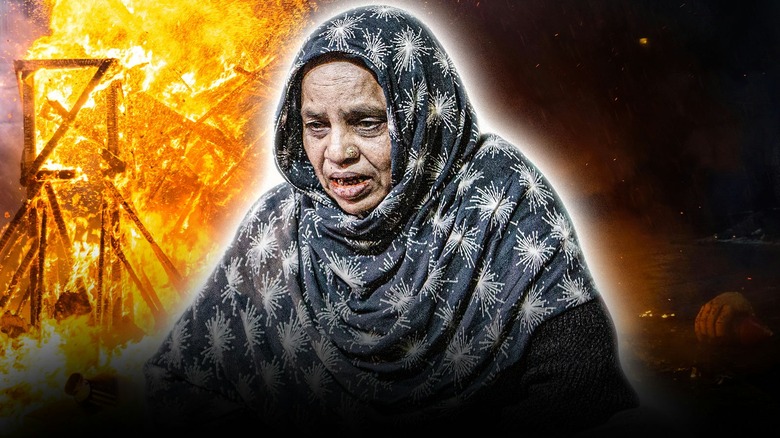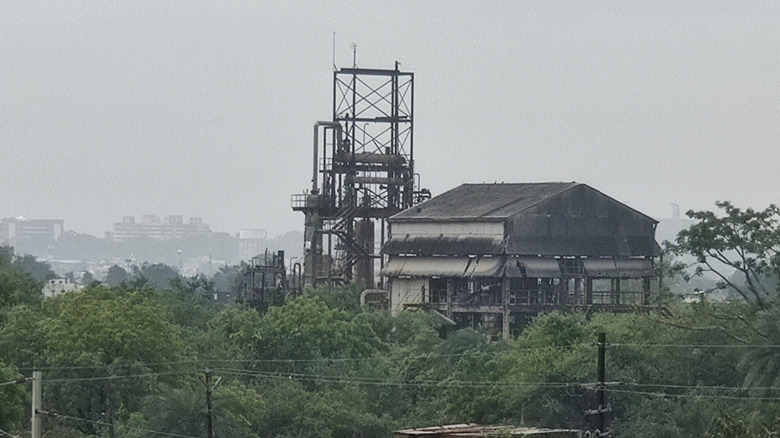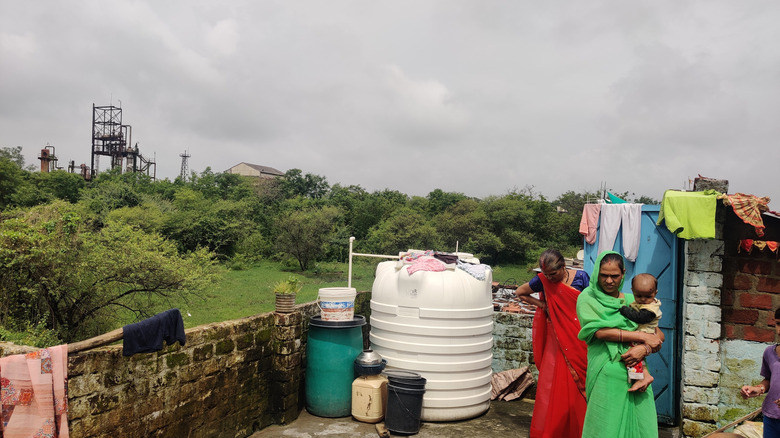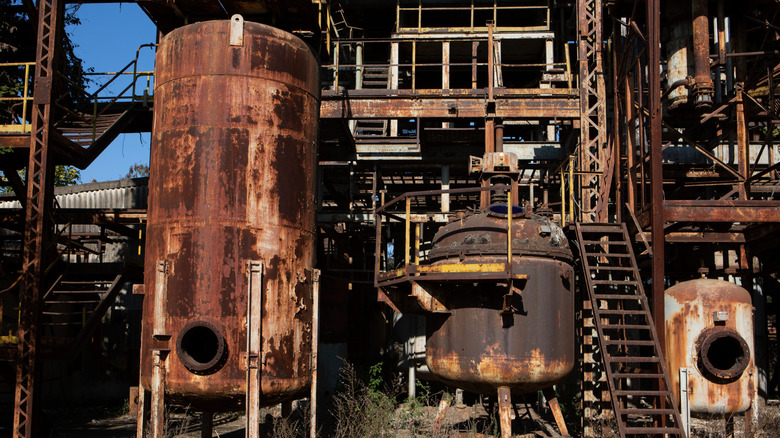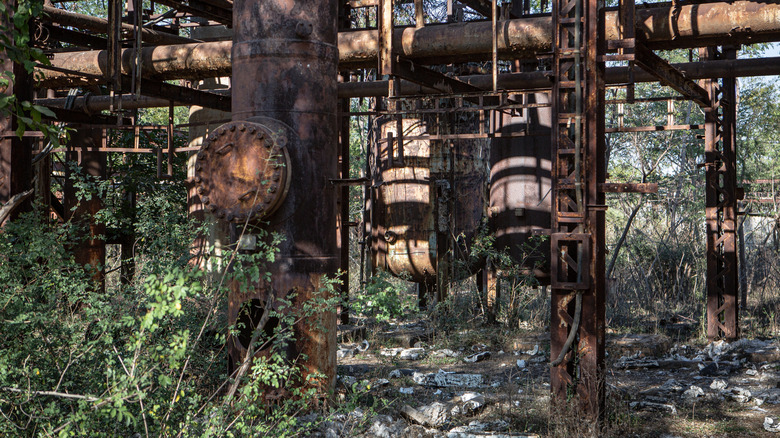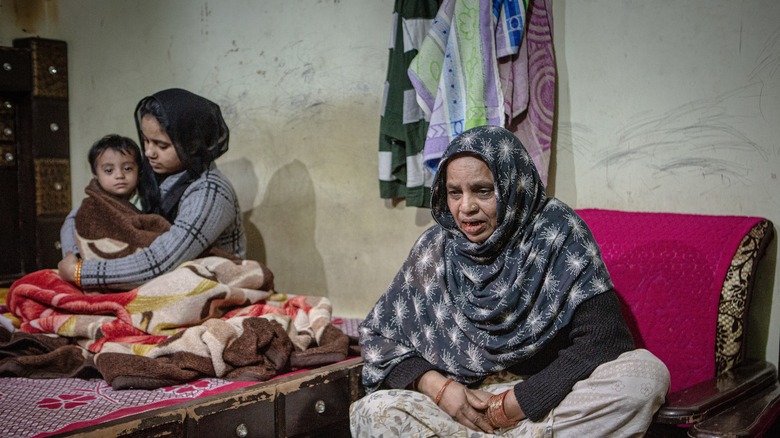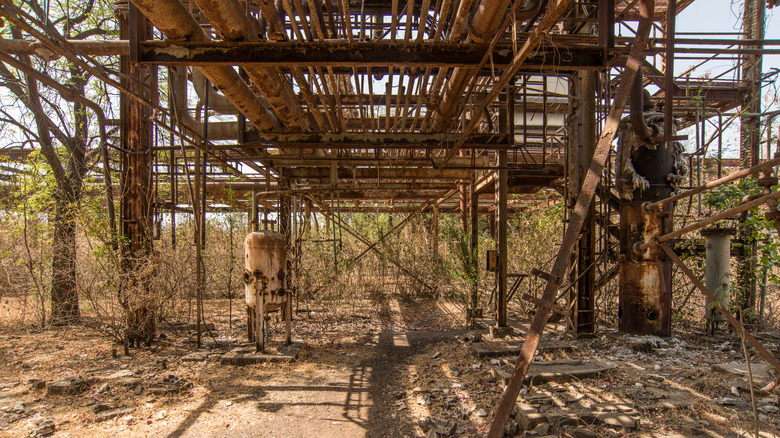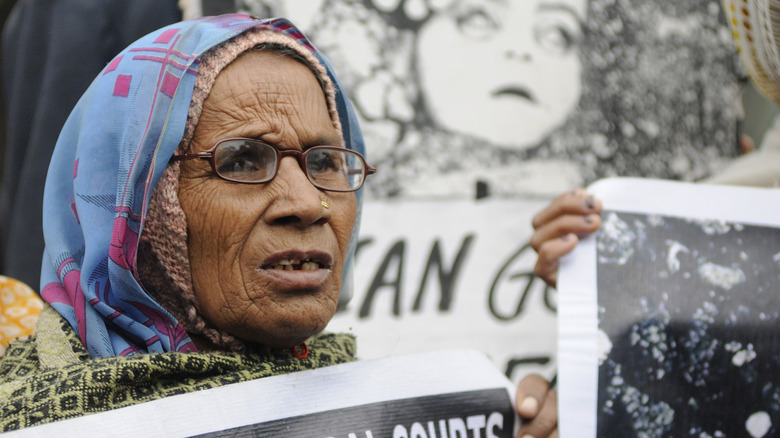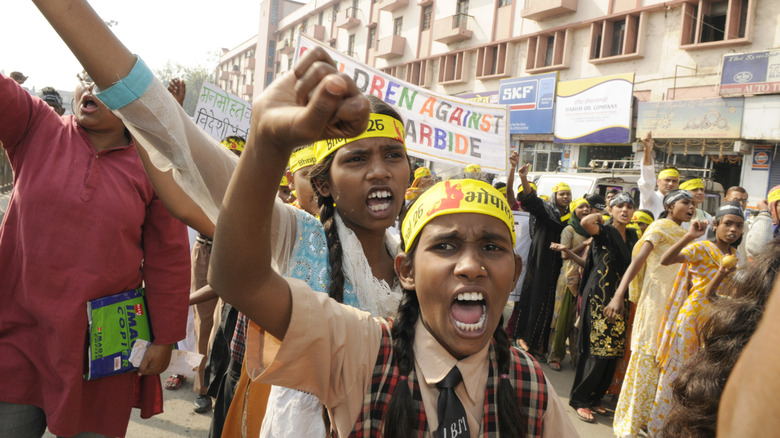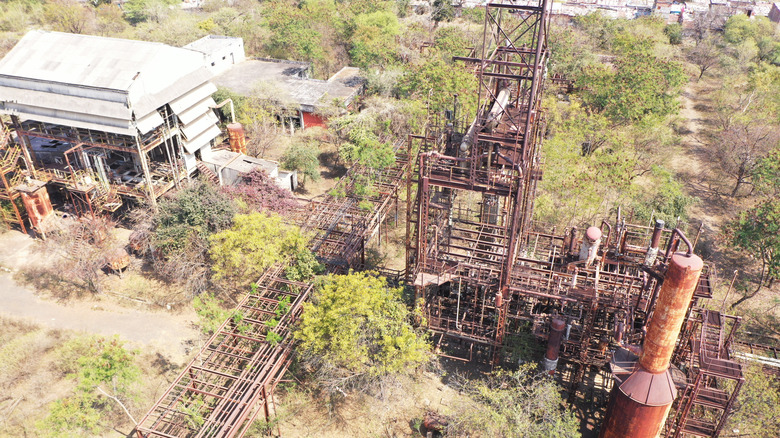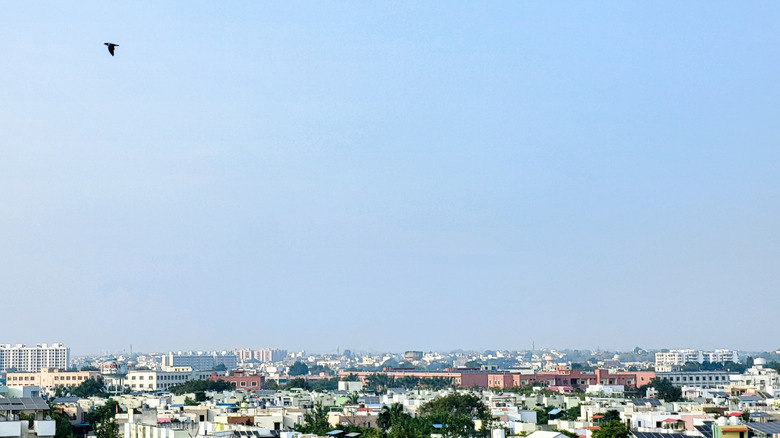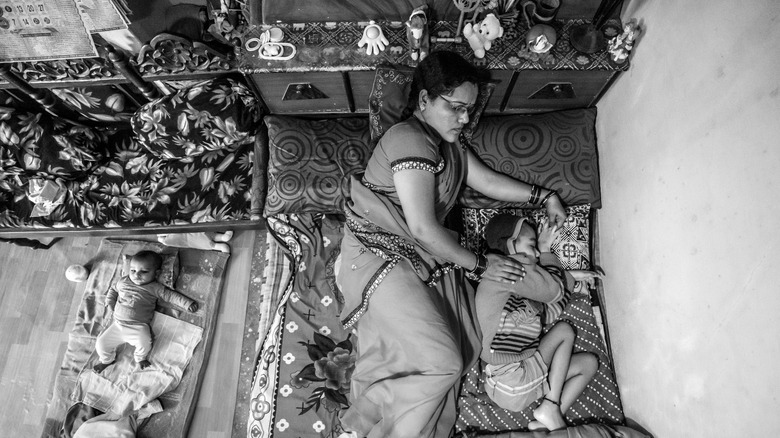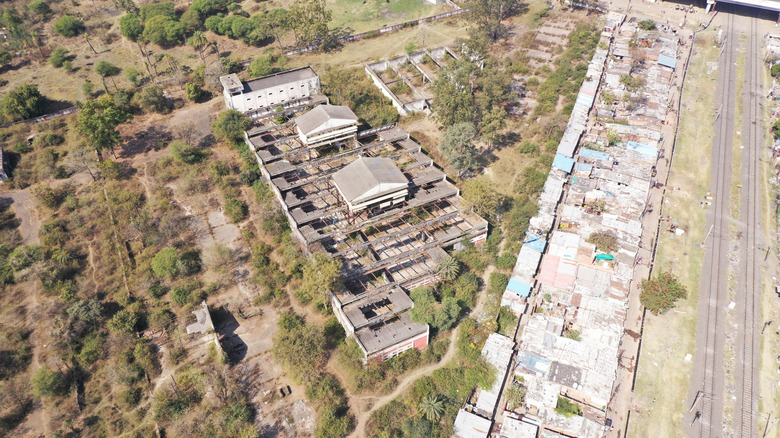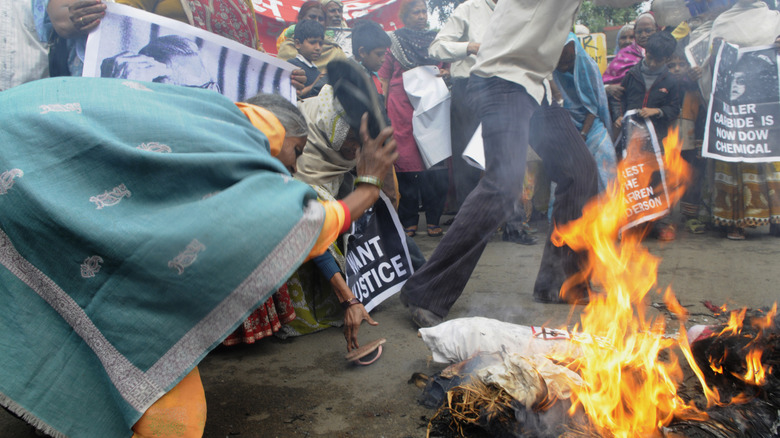Why The Bhopal Union Carbide Disaster Was Worse Than You Thought
On December 3, 1984, a Union Carbide Corporation pesticide factory experienced a series of top-down failures that eventually unleashed around 45 tons of methyl isocyanate into the poor slums of Bhopal, India. At least 3,800 of the people of Bhopal died that day as panic consumed the small town. Over the following years, experts and advocates have placed the final death toll in the tens of thousands, accounting for the countless victims who suffered long, slow, painful deaths. Many survivors escaped with their lives but struggled with ongoing disabilities that still plague them decades later. Bhopal is the site of the world's worst industrial disaster of all time, and far too few people outside India know about it.
In the United States and around the world, the Chernobyl disaster holds a place of overwhelming cultural prominence. Just about every American knows someone who knows way too much about Chernobyl and its grim cover-up, but a wide selection of other nightmarish industrial catastrophes disappear into widespread ignorance of history. Bhopal dwarfs those in many ways, yet disaster aficionados turn a blind eye. Those who know about Bhopal know that the history behind the tremendous death toll makes the Union Carbide disaster much worse than many people think.
Union Carbide was partially owned by the Indian government
Union Carbide Corporation (UCC) was an American conglomerate that initially didn't do much business with India. It came into existence during World War I, manufacturing a variety of chemical goods for the United States military before transitioning into a titan of industry. UCC sold the first antifreeze and portable radio batteries, and it pioneered market research as a discipline. Over the following decades, it found success in Asia with a pesticide called Sevin, leading the company to seek further development in India. This was to be fateful, as India was aggressively seeking international investment, leading to a mutually beneficial business arrangement.
India owned 22% of the Union Carbide India Limited subsidiary, which operated the factory in Bhopal. In total, Indian investors and banking interests — both private and government-controlled — owned a total of 49.1% of the subsidiary, while Union Carbide owned the controlling 50.9% stake. The nation explicitly asked the foreign company to build the factory in Bhopal, suggesting that the government's desire for foreign money resulted in this ill-fated factory's placement among their slums. Union Carbide India followed far less strict safety and regulatory standards than it did in a sister factory in West Virginia. When disaster naturally followed, the people of Bhopal had to rely on the Indian government, one of the biggest financial owners of the offending factory, to grant them their restitution.
Union Carbide violated zoning rules for profit
Bhopal is the capital city of central India's Madhya Pradesh state, and has an estimated population of over 2 million people. The city spans over 110 square miles with a wide variety of industrial and residential environments. The varied landscape ensures that not every area can accommodate every type of business, raising massive questions about the location of the Union Carbide Corporation (UCC) pesticide plant. The area that UCC built its factory in was convenient for transportation purposes, but it was not zoned for hazardous materials, and it was surrounded on all sides by densely packed, poor neighborhoods.
UCC initially intended to use the Bhopal plant to manufacture its popular pesticide products with methyl isocyanate, bringing the deadly material into the area in relatively small quantities. In time, UCC decided to consolidate several far more hazardous and complicated procedures into a single factory, massively increasing the risk to the surrounding areas. This danger only increased further as UCC moved to dismantle and move the Bhopal factory to another developing nation, robbing the active industrial environment of many of its key safety features and oversight. If the factory were built in an area that could better accommodate the factory's unique products, far fewer people would have suffered the almost inevitable results of its negligence.
The workers knew something was wrong
Unlike Chernobyl, the workers of Bhopal's Union Carbide plant didn't suffer the first casualties of its disaster, but they did see it coming. Over a week before the leak consumed the city, employees within the plant started to notice odd issues throughout the factory. One of many tanks of methyl isocyanate gave the workers trouble, refusing to yield the deadly chemical regardless of how much nitrogen they pumped into it. Nitrogen had to be leaking somewhere, but that didn't stop them from washing one of the pipes with many gallons of water. An employee noticed that the pipe wasn't sealed properly; water reacts violently with methyl isocyanate, which would cause the eventual disaster.
Employees also noticed and ignored an abnormal increase in pressure on one of the instruments in the plant, leading them to miss key indicators until it was too late. The signs that eventually caused workers to panic only came when it was far too late. The methyl isocyanate leak gradually grew out of control, resulting in sounds a worker later described to The New York Times as "a tremendous sound, a messy boiling sound, underneath the slab, like a caldron." By the end, they watched helplessly as the white cloud of toxic material escaped a massive crack in the concrete and sped off toward the populace.
Union Carbide used workers as leak detectors
Post-mortem coverage of the Bhopal disaster revealed some of the most nightmarish lapses in safety ever to plague a factory. Union Carbide India Limited offered extremely limited protections to its employees, and also robbed them of most of the critical tools they needed to perform their tasks safely. For one, the overwhelming majority of employees had not read the safety guides that explained how to work with methyl isocyanate. That information would have been extremely helpful to a team with proper equipment, but the workers in Bhopal didn't even have that benefit. According to one worker who spoke to The New York Times, "instruments often didn't work," forcing them to rely on their own pain to detect leaks.
Employees reported apparent gas leaks when their eyes started to water, leading one worker to describe the staff as "human leak detectors." That practice was a flagrant violation of the manual that governed their industrial work, but it became standard in the Bhopal plant. Unfortunately, this gave the workers a very limited time period to respond to potential leaks. It also impaired their ability to continue working, as they had to begin suffering the early effects of methyl isocyanate poisoning while hunting for a leak. A functioning factory with tight safety regulations would likely have responded much better to the leak.
Locals could have survived with more information
One of the many ways Union Carbide India Limited failed to prepare for a possible disaster at their Bhopal plant was its unwillingness to provide clear, helpful instructions to the locals. The pesticide plant skimped on a wide variety of important safety features, but in addition to underpreparing its workers, it utterly failed to prepare the citizens of Bhopal for the proper procedures in the event of a disaster. The operating company struggled to inform locals of anything, seemingly intent on avoiding the cost of fliers or newspaper ads. The factory featured a comprehensive alarm system, but they went off so frequently that their warnings on December 3rd, 1984, went ignored.
When the Union Carbide factory began leaking, the citizens had no idea what toxic substance was killing them and their neighbors. Many died in their sleep, suffering very briefly before their passing. Most notably, neither the locals nor their doctors knew that the best precaution against methyl isocyanate was a wet cloth over the face. Officials at the time blamed the company for hiding the dangerous materials they were working with and failing to educate local authorities on what to do in the case of a disaster.
The death toll is highly disputed
Immediately after the Bhopal disaster, two groups entered an endless conflict. Union Carbide did everything it could to downplay the disaster and its role in it, while advocates and attorneys for the victims fought to force the corporation to take responsibility. One of the most important battlefields came in the ostensibly impartial work of counting the dead. The immediate estimates placed the day's death toll just above 3,800, but the numbers become far less precise immediately thereafter. In the following few days, estimates of 8,000, 10,000, and even 15,000 became commonplace.
Tracking the long-term effects of the disaster is even more difficult: At least half a million people were exposed to methyl isocyanate gas, and that exposure can cause any number of long-term health issues. While it is certainly possible that not every person in the massive affected area fell prey to some life-altering medical condition, we may never accurately know how many premature deaths occurred as a direct result of the Bhopal disaster.
Thousands still have chronic health issues
Thousands of people died in the 1983 Bhopal disaster, but many who survived did so with a vastly decreased quality of life. Exposure to methyl isocyanate can result in a catastrophic list of potential disorders, many of which drastically lower the victim's lifespan while also rendering them far less able-bodied. As many as half a million citizens of Bhopal could have inhaled or felt the chemical in the extended window of its involvement, with many other victims suffering its impact through contaminated soil or groundwater.
Victims as young as 2 years old had conditions like chronic renal failure, locking them into a lifetime of dialysis after only moments of exposure. In the 2020s, many of these victims are still alive, undergoing daily medical visits to deal with the impact. In less severe cases, a ton of Bhopal citizens experienced vision or respiratory issues that remained for the rest of their lives. Perhaps most disconcertingly, a number of babies born in the area had birth defects that could end their lives very early. The death toll was a tragedy, but many people are still living with the scars of the Bhopal disaster, further cementing it as one of the world's worst man-made disasters.
Union Carbide paid out very little compensation
In the immediate aftermath of the Bhopal disaster, Indian courts set to work determining how to get help to the people who needed it. Union Carbide tried to deny blame, but its efforts soon became futile as damning information came to light. American lawyers moved quickly, attempting to drop a multi-billion dollar suit on the American company's Indian branch, only to have India take over the proceedings. With the Bhopal Gas Leak Disaster Act of 1985, the Indian government took on all the work of legally representing the victims, kicking off a lengthy legal battle with shockingly small results.
Union Carbide Corporation eventually accepted blame and paid out a whopping $470 million to the Indian government, which then distributed it to the victims. That may seem like a weighty sum, but the company had reported net earnings around $323 million in 1984. If Union Carbide had been held to the same standards as the U.S. cases against companies that mined asbestos, it would have been on the hook for more money than its $10 billion insurance coverage was worth.
Union Carbide's current owners refuse to clean up
Union Carbide Corporation (UCC) started denying blame the moment the gas leaked into Bhopal, instead pointing the finger at its Indian subsidiary for failing to maintain the plant. It also briefly pitched a fake story about an extremist group, which barely lasted a few hours before onlookers saw through it. These dodgy tactics only partially absolved the corporation, eventually leading to a financial settlement and the complete divestment of Union Carbide India Limited, which went to an Indian company called Mcleod Russell India Limited. Union Carbide, however, eventually became the property of Dow Chemical, which immediately picked up the torch of denial.
Dow started buying UCC in 1999 and finished the deal in 2001. According to the dedicated page Dow uses to deny involvement in the Bhopal tragedy, while it is the exclusive owner of every commercial share of Union Carbide, it did not inherit any of the company's liabilities. Dow also abdicates itself from any settlements for Union Carbide's other chemical disasters, including the latter's involvement in the asbestos issues in America. Dow blames the divested Indian branch of its subsidiary and the Indian government, continuing a trend of American companies putting the blame on other countries. The slow and painful process of cleaning up UCC's mess received no help from the company's new owners.
Bhopal's environment is still devastated
While the human cost of Bhopal was obviously massive, the damage to the surrounding environment is on par with the worst toxic spills in history. The methyl isocyanate in the Bhopal factory tainted the ground it stands on and the surrounding soil for generations to come, decades after the day of the disaster. In 1999, tests of local wells and groundwater revealed tremendous concentrations of mercury and other carcinogenic chemicals. The potable water in the area serves no less than 15 distinct communities containing countless people, but it consistently contains a variety of hazardous materials.
Further studies at Bhopal have revealed the presence of toxic chemicals and heavy metals like lead in nearly everything, including soil, vegetation, and even breastmilk. In a 2009 report for the Bhopal Medical Appeal (via Scientific American), its author Colin Toogood stated, "There are parts of the factory where the soil you walk on is 100 percent toxic waste." Several lifelong medical issues have also become far more common in the area, including birth defects, widespread cancer, and neurological damage.
Very few employees paid for their crimes
The process of assigning blame after a disaster can often take an astonishingly long time. Lawyers and government agencies in the United States and India started moving to seek justice almost immediately after the Bhopal incident, but the process took ages and came with several considerable oversights. Authorities initially sought to bring the hammer down on Warren Anderson, the executive over Union Carbide at the time of the disaster, but the United States repeatedly refused to extradite him. Anderson was out of the leading role by the time anyone tried to punish him, and he died at 92 without serving time.
The executives who did suffer punitive measures after the Bhopal disaster were all Indian men around 70 years old. Seven former senior employees of Union Carbide India Limited were convicted of death by negligence in 2010. They received India's maximum punishment for the charge: two years in prison and a 100,000 rupee fine. Many advocates for the victims took to the streets to argue that their sentences were far too light given the cost of the Bhopal disaster. They immediately went home on bail and started a lengthy appeal process to keep them out of prison.
India is still working to get rid of the waste
The process of cleaning up the tremendous chemical waste at the Union Carbide plant has been an ongoing effort since the initial disaster and resulting shutdown. Union Carbide Corporation quickly washed its hands of the issue, doing everything in its power to deny blame and avoid accountability just as it did in the other disasters it caused, including some of the deadliest mining disasters in history. Union Carbide India Limited and its eventual new owners did some work to clean up the mess, but the Indian government eventually took over with a very slow-moving plan to deal with the waste.
India intended to landfill or incinerate the hazardous material from 2007 onward, but the actual process didn't begin until testing in 2015. After successful trial runs, the government decided to incinerate the rest of the chemicals at the risk of massive protests. By December 2024, India ordered the removal of 337 metric tonnes of toxic solid waste in 12 massive containers, driving them out of Bhopal and into a more industrial area for incineration at the start of 2025. Protestors still aggressively argue that Dow Chemical, Union Carbide's current owner, should handle the cleanup, but at least the toxic contaminants are finally starting to clear up.
Many of the same mistakes are still being made
There were many lessons to take away from the Bhopal disaster, but most of them are very hard to learn, especially in the face of corporate greed. Union Carbide was an American company that set up an Indian subsidiary to profit from the nation's desire for foreign investment, and its safety standards were drastically lower than they were in its American-based sister factory, representing one of the worst cases of environmental racism in history. If India had stricter standards on companies, refusing to allow foreign industries to subvert regulations and flaunt safety standards, the Bhopal incident may never have occurred. Unfortunately, India is still practicing much of the same leniency in pursuit of profit.
There is still a silver lining in the form of what the people learned from Bhopal. In 1994, a decade after the disaster, Dupont wanted to build a nylon factory in Goa with the stipulation that they'd be completely free from liability if the hazardous chemicals they were working with caused issues. Through a powerful protest movement — in which some lost their lives — the people of Goa fought off the company and forced Dupont to retreat. The Indian government may not have learned from the mistakes that led to the Bhopal disaster, but the citizens remember.
